Exploring Habitats
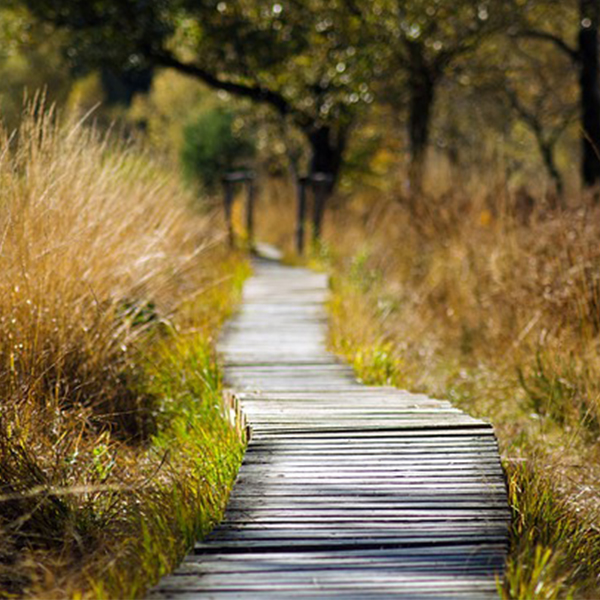
Trail through a natural area (smellypumpy, Pixabay)

Trail through a natural area (smellypumpy, Pixabay)
How does this align with my curriculum?
| Grade | Course | Topic |
|---|
Students will make observations and inferences about three different habitats.
Overview
| Activities | Timing | Student Grouping | Description |
|---|---|---|---|
| Minds-On: Activating Prior Knowledge | 10 - 15 minutes | Small group | Students recall experiences they have had in nature. |
| Action: Take a (Virtual) Hike | 35 - 45 minutes | Large group followed by small group | Students take a virtual and/or actual hike through different habitats and record what they observe. |
| Consolidation: Summarizing Habitats | 10 - 15 minutes | Small group and Independent | Students demonstrate what they have learned about habitats. |
This lesson can be done over a few days. If the option is available, replace the virtual hikes with a hike to a local habitat or follow up with a hike to a local habitat. Alternatively, intersperse images or key words around the school yard to mimic hiking through different habitats.
Students will:
- Understand that habitats are areas that provide organisms, including plants and animals, with the necessities of life
- Recognize that the features of a habitat can predict the plants and animals that will be found there and that the types of plants and animals living in a habitat tells us a lot about the habitat
Learning Goals
Students will:
- Understand that habitats are areas that provide organisms, including plants and animals, with the necessities of life
- Recognize that the features of a habitat can predict the plants and animals that will be found there and that the types of plants and animals living in a habitat tells us a lot about the habitat
Students can:
- Identify and list the things a specific habitat provides for the plants and animals living there
- Make conclusions about habitats when given information about the plants and animals living there
- Make conclusions about the plants and animals that can live in a habitat when given physical information about the habitat
Success Criteria
Students can:
- Identify and list the things a specific habitat provides for the plants and animals living there
- Make conclusions about habitats when given information about the plants and animals living there
- Make conclusions about the plants and animals that can live in a habitat when given physical information about the habitat
This icon indicates potential assessment opportunities.
Observations
- Observe student contributions as they make conclusions about what their observations tell them about the habitats (Action)
Conversations
- Listen to student discussions for the correct use of scientific terms as they discuss the three habitats and make conclusions (Action)
- Have conversations with students about the characteristics of habitats, listening for their correct use of scientific terms (Action)
- Listen to students as they make conclusions from their observations for accuracy and appropriateness (Action)
Products
- Review the Virtual Hike Observations recording sheet for appropriate observations (Action)
- Review the Making Inferences recording sheet for appropriate conclusions (Action)
- Review the Exploring Habitats Exit Slip for appropriate statements and conclusions (Consolidation)
Evidence of Student Learning
This icon indicates potential assessment opportunities.
Observations
- Observe student contributions as they make conclusions about what their observations tell them about the habitats (Action)
Conversations
- Listen to student discussions for the correct use of scientific terms as they discuss the three habitats and make conclusions (Action)
- Have conversations with students about the characteristics of habitats, listening for their correct use of scientific terms (Action)
- Listen to students as they make conclusions from their observations for accuracy and appropriateness (Action)
Products
- Review the Virtual Hike Observations recording sheet for appropriate observations (Action)
- Review the Making Inferences recording sheet for appropriate conclusions (Action)
- Review the Exploring Habitats Exit Slip for appropriate statements and conclusions (Consolidation)
Students will:
- Understand that habitats are areas that provide organisms, including plants and animals, with the necessities of life
- Recognize that the features of a habitat can predict the plants and animals that will be found there and that the types of plants and animals living in a habitat tells us a lot about the habitat
Learning Goals
Students will:
- Understand that habitats are areas that provide organisms, including plants and animals, with the necessities of life
- Recognize that the features of a habitat can predict the plants and animals that will be found there and that the types of plants and animals living in a habitat tells us a lot about the habitat
Students can:
- Identify and list the things a specific habitat provides for the plants and animals living there
- Make conclusions about habitats when given information about the plants and animals living there
- Make conclusions about the plants and animals that can live in a habitat when given physical information about the habitat
Success Criteria
Students can:
- Identify and list the things a specific habitat provides for the plants and animals living there
- Make conclusions about habitats when given information about the plants and animals living there
- Make conclusions about the plants and animals that can live in a habitat when given physical information about the habitat
This icon indicates potential assessment opportunities.
Observations
- Observe student contributions as they make conclusions about what their observations tell them about the habitats (Action)
Conversations
- Listen to student discussions for the correct use of scientific terms as they discuss the three habitats and make conclusions (Action)
- Have conversations with students about the characteristics of habitats, listening for their correct use of scientific terms (Action)
- Listen to students as they make conclusions from their observations for accuracy and appropriateness (Action)
Products
- Review the Virtual Hike Observations recording sheet for appropriate observations (Action)
- Review the Making Inferences recording sheet for appropriate conclusions (Action)
- Review the Exploring Habitats Exit Slip for appropriate statements and conclusions (Consolidation)
Evidence of Student Learning
This icon indicates potential assessment opportunities.
Observations
- Observe student contributions as they make conclusions about what their observations tell them about the habitats (Action)
Conversations
- Listen to student discussions for the correct use of scientific terms as they discuss the three habitats and make conclusions (Action)
- Have conversations with students about the characteristics of habitats, listening for their correct use of scientific terms (Action)
- Listen to students as they make conclusions from their observations for accuracy and appropriateness (Action)
Products
- Review the Virtual Hike Observations recording sheet for appropriate observations (Action)
- Review the Making Inferences recording sheet for appropriate conclusions (Action)
- Review the Exploring Habitats Exit Slip for appropriate statements and conclusions (Consolidation)
Materials and Preparation
| Material/Technology/Setting | Quantity |
|---|---|
|
1 per student |
Note: in the event that a real hike is possible, ensure students are prepared for an outdoor excursion (e.g., wearing appropriate clothing and footwear). |
1 per group |
|
For teacher use |
Materials
| Material/Technology/Setting | Quantity |
|---|---|
|
1 per student |
Note: in the event that a real hike is possible, ensure students are prepared for an outdoor excursion (e.g., wearing appropriate clothing and footwear). |
1 per group |
|
For teacher use |
- Set up a computer and projection device with audio to show videos.
Preparation
- Set up a computer and projection device with audio to show videos.
- Familiarity with the basic needs of living things.
- Understanding that different plants and animals have different needs.
- General understanding of what habitats are.
Student Prior Knowledge and Skills
- Familiarity with the basic needs of living things.
- Understanding that different plants and animals have different needs.
- General understanding of what habitats are.
| Material/Technology/Setting | Quantity |
|---|---|
|
1 per student |
Note: in the event that a real hike is possible, ensure students are prepared for an outdoor excursion (e.g., wearing appropriate clothing and footwear). |
1 per group |
|
For teacher use |
Materials
| Material/Technology/Setting | Quantity |
|---|---|
|
1 per student |
Note: in the event that a real hike is possible, ensure students are prepared for an outdoor excursion (e.g., wearing appropriate clothing and footwear). |
1 per group |
|
For teacher use |
- Set up a computer and projection device with audio to show videos.
Preparation
- Set up a computer and projection device with audio to show videos.
- Familiarity with the basic needs of living things.
- Understanding that different plants and animals have different needs.
- General understanding of what habitats are.
Student Prior Knowledge and Skills
- Familiarity with the basic needs of living things.
- Understanding that different plants and animals have different needs.
- General understanding of what habitats are.
Teaching and Learning Activities
This icon indicates potential assessment opportunities.
Minds-On: Activating Prior Knowledge (10 - 15 min.)
| Instructions | Teaching Tips |
|---|---|
|
Begin by engaging students in a think-pair-share to activate and build their knowledge related to places in nature (habitats).
|
IdeaTo reduce discussion time on who should be the first to share, set easily recognized criteria students can use to quickly decide (“the person with the shortest (longest) hair goes first”, “the person with the most colourful clothes goes first”, “the tallest (shortest) person goes first”). Provide the criteria in advance so it is not a surprise to the students. Community ConnectionsIt is important to note that students will have different lived experiences and understandings of the world around them. Some students may not have had the opportunity to visit natural areas in their lives, so be mindful of their different perspectives. DiscussionsThinking prompts can include:
|
|
Clarify that when we talk about a place in nature, the science term for this is “habitat”. Ask students to come up with a definition of what a habitat is and why habitats are important for living things. Help students refine their definition to something like the following: a habitat is a place where an organism, such as a plant or animal, lives. It provides an organism with everything that they need to live and reproduce. This includes food, water and space. Students may need further support for triggering their knowledge. You could do this by showing students this slideshow about habitats [Google slides] [pptx] [PDF]. 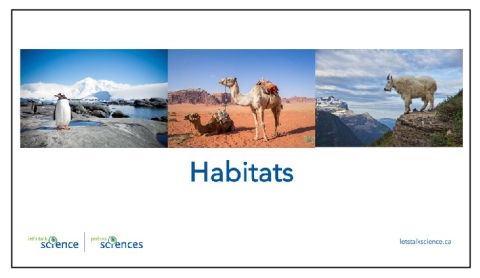
|
LanguageCreate an ongoing list of words and phrases related to the concepts being studied by creating a word wall or having students create a personal dictionary (digital or hardcopy). Students can group the words/phrases in the list in a variety of ways. For French language classrooms make the connection between the term “habitat” and the verb “habiter”. |
|
Based on the places in nature that they had previously thought about, have students identify any plants and animals that would live there. If students are not sure of the names of the plants and animals, they could describe them instead (e.g., tall trees, lots of bugs, colourful flowers, etc.). |
DiscussionsDiscussion prompts can include:
|
Action: Take a (Virtual) Hike (35 - 45 min.)
| Instructions | Teaching Tips |
|---|---|
|
Explain to students that the class is going to take three virtual hikes. Each hike will be through a different habitat. As they view each hike, they should remain as quiet as possible. On each hike, they will make observations of the different plants and animals they see or hear. Try to imagine they are actually taking the hike. Listen carefully to the sounds and pay attention to the plants. Play each video for 1-2 minutes to provide enough time for students to get a sense of what the habitat is like. Note: Alternatively or in addition to, at this point you could take students for an actual hike in a natural space outdoors. Another option would be to intersperse images or key words around the school yard to mimic hiking through different habitats. |
Images and VideosPause the videos at 2 or 3 places to provide students with sufficient time to make their observations and sketches. Community ConnectionsAs we study different habitats, we learn there are different plants, animals and other things such as water, air, and sun present. When we think of habitats, it is also important to recognize that these things were on Earth before us. In addition, there were many people on the lands before us and there will continue to be people on lands after us. In Canada, or what many Indigenous people refer to as Turtle Island, there are many diverse First Nations, Inuit and Metis groups that view land as places and homes for all those human and non-human inhabitants. It is important to remember that these diverse First Nations, Inuit and Metis groups are still around. Some are our friends, neighbours, our classmates or members of our families. As we learn about habitats and the relationships, let us also think of all those who have been on the land before us, as well as those who will be on the land afterwards. |
|
Provide each student with a copy of the My Hike Observations reproducible [Google doc] [Word doc] [PDF] and have them record what they observe. Students may choose to write and/or draw what they observe. Remind them to be as specific as they can, use words to describe the color, size, where things are located, and quantity (e.g., if there are many or just a few trees). As they listen to the sounds, ask them to try to identify if it is one sound or many sounds. Ask them to think about if they heard sounds like this before and, if so, what made those sounds. 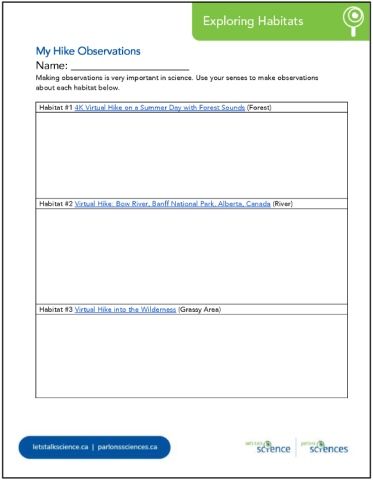
Begin by showing the video of a hike through a forested area (4K Virtual Hike on a Summer Day with Forest Sounds). Follow this with this video of a hike along a river (Virtual Hike: Bow River, Banff National Park, Alberta, Canada) Conclude with this video of a hike through a grassy habitat (Virtual Hike into the Wilderness). |
IdeaThis is a good opportunity to clarify with students that not all scientific investigations are done in the lab or by doing experiments. Making observations in nature can also lead to scientific knowledge as it is an integral part of the scientific investigation process. DiscussionsDiscussion prompts can include:
Images and VideosStudents and teachers could describe what kinds of sounds they are hearing in the video for students who have auditory impairments. As well, the scenes from the videos could be described in detail to students who have visual impairments. |
|
Organize students in pairs or groups of three. Have them share the observations they made about each of the habitats during the virtual hikes. Students can add new or missing information to their own sheets. After students have shared their observations, explain to them that they are now going to use the data (information) they have collected to learn more about the habitats they observed. Remind students that observations are taken in through their senses. When they start to analyze or “make sense” of their observations, they are making an inference. Inferences are based on what we know about the subject. This is what scientists do after they make observations or collect data. They use their background knowledge of the topic they are studying to make conclusions based on what they observed. Together, observations and inferences are a very powerful tool in scientific investigations. Provide each group with a copy of the Making Inferences reproducible [Google doc] [Word doc] [PDF]. Explain to them that they will record their observations in this table and make inferences about what these observations tell them about the habitats. For clarification, two sample entries have been made. 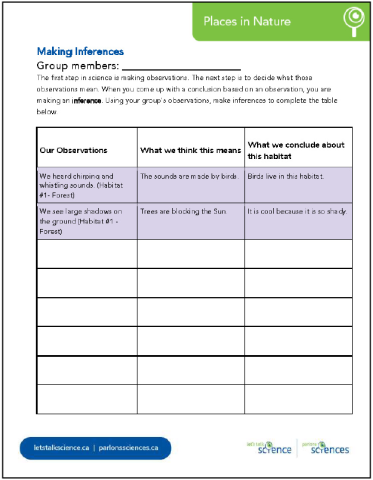
|
IdeaThis is a good opportunity to remind students that observations must be contextualized for meaning and connection. Another example of contextualizing can also include stories and legends passed down from generation to generation. When we analyze observations, we are using our background knowledge (i.e., what we already know about the world). For example, if we have never heard bird songs before, the sounds we hear would not make any sense to us. Similarly, we might misinterpret the chirp of a cricket (e.g., in the grassy habitat) for that of a bird. If we did not know that plants need water, we would not be able to conclude that, with all the green plants in these habitats, there must be water available in these habitats. |
|
Lead a class discussion to debrief the conclusions students made about the habitats using their observations. If students mistakenly present something that is an inference as an observation, clarify the distinction. For example, if students say they hear a sound, they are making an observation. We observe with all of our senses. If they then say that they think there is a bird making that sound, they are making an inference. Our inferences come from our lived experiences. So the student may have some prior experience with birds and the sounds they make. They cannot be sure that the bird is in the tree, without making further observations. |
DiscussionsDiscussion prompts can include:
|
|
Remind students of the definition of habitat as an area in nature that provides the plants and animals that live there with the things they need to stay alive (i.e., food, water). Engage students in a discussion on which necessities of life these habitats provide to plants and animals. Clarify for students that for plants, the things they need for life are sunlight, food from the soil, soil to grow in, water and space to grow. For animals, the things they need are food, shelter, space to move, and water. Point out that even if a habitat has water, food, shelter, and space, it might not be a good habitat for a particular plant or animal. For example, while a park has a fair amount of space for squirrels, it would not be enough for a bear. A habitat might have temperatures that suit some animals but not others (e.g., a polar bear needs a colder habitat). If the habitat is very wet (e.g., a marsh or bog) only certain plants adapted to live in wet conditions can grow there (i.e., it might be too wet for an apple tree). Finally, a lake or pond can only be a habitat to certain plants and animals. |
DiscussionsDiscussion prompts can include:
|
Consolidation: Summarizing Habitats (10 - 15 min.)
| Instructions | Teaching Tips |
|---|---|
|
Debrief the activity as a class. Ask students if they have any questions related to what they learned or did in this lesson. |
DiscussionsDiscussion prompts can include:
|
|
To conclude the lesson, and provide time for consolidation of new information, have students complete the Exploring Habitats Exit Slip reproducible [Google doc] [Word doc] [PDF]. 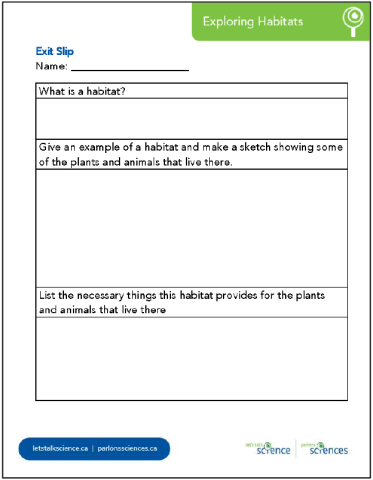
|
The Exit Slip can be completed as an outside of class activity. |
Background Information for Teachers
Habitats
Habitats are places in nature that provide the plants and animals living there with the things they need to survive. These things include shelter, food, water, air and space. The amounts of these things will differ from one habitat to another.
The particular amounts and distribution of these elements will determine the types of plants and animals that can survive there. For example, a park or backyard would have lots of space and food available for field mice but would not have enough space for a deer.
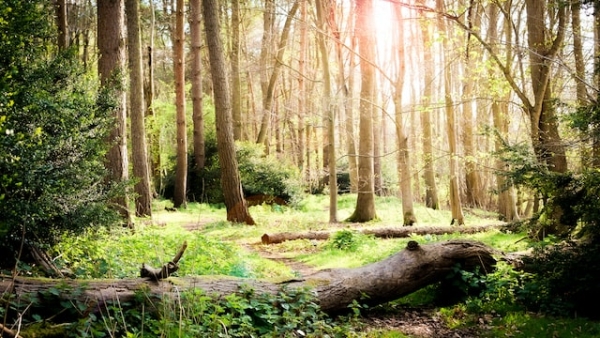
Image - Text Version
Shown is a colour photograph of a small clearing in a dense forest.
The forest floor is covered in green grass and low plants. These are lit by warm sunlight peeking through the trees. A fallen trunk stretches across the bottom edge of the image, and another lies just beyond it. Evergreen trees frame the left and right edges. Long, thin tree trunks take up the centre of the image, reaching up to the top edge.
Some habitats have materials that may be necessary for human society. For example, minerals, oil, wood or other building materials. Normally, before humans can exploit such habitats a study is done to determine the possible impact on the environment of that habitat. Many issues are considered. These include such things as if the habitat is rare or if it contains plants or animals not found elsewhere. Sometimes the decision to go ahead is based on the economic needs of society, even though it is recognized that the habitat will be changed. When a habitat is changed, the things the habitat provides to the plants and animals also change. As a result, the original plants and animals may no longer be able to live there.
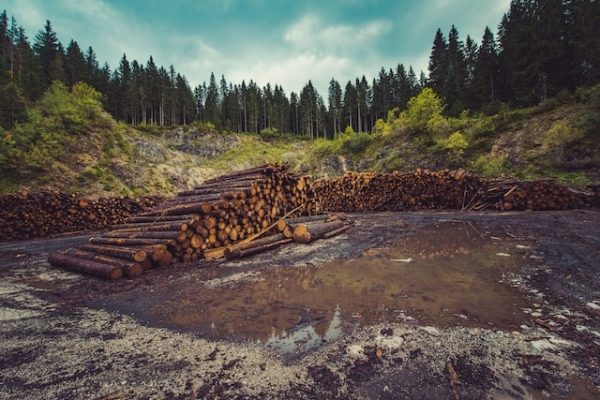
Image - Text Version
Shown is a colour photograph of a large pile of cut logs in front of a forested area.
The foreground is a wide, flat clearing of brown mud. Two long stacks of logs stretch across the middle of the image. All the logs are exactly the same length, making the stacks uniform. Above is a steep hill coved in pale green vegetation, topped by a strip of evergreen trees. The sky is bright blue with wispy cloud.
Additional Resources
Reproducibles
- My Hike Observations reproducible [Google doc] [Word doc] [PDF]
- Habitats slideshow [Google slides] [pptx] [PDF]
- Making Inferences reproducible [Google doc] [Word doc] [PDF]
- Exploring Habitats Exit Slip reproducible [Google doc] [Word doc] [PDF]
Reproducibles and Media
Reproducibles
- My Hike Observations reproducible [Google doc] [Word doc] [PDF]
- Habitats slideshow [Google slides] [pptx] [PDF]
- Making Inferences reproducible [Google doc] [Word doc] [PDF]
- Exploring Habitats Exit Slip reproducible [Google doc] [Word doc] [PDF]
Science
- Students could discuss the importance of protecting certain habitats.
- Students could examine the positive and negative impacts of human activities on habitats, including the establishment of walking trails such as seen in the three virtual hikes.
- Students could discuss what characteristics a habitat should have in order to become protected from human development.
- Students could use their observation skills as part of a citizen science activity such as those listed on the Government of Canada, Citizen Science Portal.
Literacy
- Students could read about specific habitats (e.g., deserts, grasslands, alpine areas, tundra, lake, marsh).
- Students could give a presentation about the characteristics of a habitat of their choice.
Visual Arts
- Students could choose a habitat that is of interest to them and create a collage poster or other visualization to describe that habitat.
- Have students take on an animal in a habitat and tell a story about this animal. They could make this into a short play or performance and design a set that depicts the habitat.
Career Connections
- Students could brainstorm the people who might have a work-related or personal connection to one of these habitats.
Extensions
Science
- Students could discuss the importance of protecting certain habitats.
- Students could examine the positive and negative impacts of human activities on habitats, including the establishment of walking trails such as seen in the three virtual hikes.
- Students could discuss what characteristics a habitat should have in order to become protected from human development.
- Students could use their observation skills as part of a citizen science activity such as those listed on the Government of Canada, Citizen Science Portal.
Literacy
- Students could read about specific habitats (e.g., deserts, grasslands, alpine areas, tundra, lake, marsh).
- Students could give a presentation about the characteristics of a habitat of their choice.
Visual Arts
- Students could choose a habitat that is of interest to them and create a collage poster or other visualization to describe that habitat.
- Have students take on an animal in a habitat and tell a story about this animal. They could make this into a short play or performance and design a set that depicts the habitat.
Career Connections
- Students could brainstorm the people who might have a work-related or personal connection to one of these habitats.
Arctic Tundra Biome
Learn about the location, plants, animals, human impacts and conservation of the arctic tundra region.
Desert Biome
Learn about the location, plants, animals, human impacts and conservation of the desert region.
Boreal Forest/Taiga Biome
Learn about the location, plants, animals, human impacts and conservation of the boreal forest/Taiga region.
Habitats
This National Geographic article summarizes the four main things provided by a habitat (i.e., shelter, water, food, space), including how the requirements for each depend on the organisms living there.
Habitats
This resource from National Geographic Kids, explores the different natural environments where plants and animals are found (includes lots of photos).
Savanna Biome
Learn about the location, plants, animals, human impacts and conservation of the savanna region.
Tropical Rainforest Biome
Learn about the location, plants, animals, human impacts and conservation of the tropical rainforest region.
What is a habitat? (2022)
This video explores four different habitats (rainforests, woodlands, seashores and oceans) including the plants and animals that live there and their basic needs.
Learn More
Arctic Tundra Biome
Learn about the location, plants, animals, human impacts and conservation of the arctic tundra region.
Desert Biome
Learn about the location, plants, animals, human impacts and conservation of the desert region.
Boreal Forest/Taiga Biome
Learn about the location, plants, animals, human impacts and conservation of the boreal forest/Taiga region.
Habitats
This National Geographic article summarizes the four main things provided by a habitat (i.e., shelter, water, food, space), including how the requirements for each depend on the organisms living there.
Habitats
This resource from National Geographic Kids, explores the different natural environments where plants and animals are found (includes lots of photos).
Savanna Biome
Learn about the location, plants, animals, human impacts and conservation of the savanna region.
Tropical Rainforest Biome
Learn about the location, plants, animals, human impacts and conservation of the tropical rainforest region.
What is a habitat? (2022)
This video explores four different habitats (rainforests, woodlands, seashores and oceans) including the plants and animals that live there and their basic needs.
4K Relaxation Channel (Oct 13, 2020). 4K Virtual Hike on a Sunny Day with Forest Sounds - Licorice Fern Trail, Issaquah Area [Video]. YouTube, https://www.youtube.com/watch?v=8PEANxq6w6s#t=3m37s
Government of Canada (n.d.). Citizen Science Portal.
Ontario Council for Technology Education (June 2020). Grade 4: Habitats and Communities.
TallSky Walker (Oct 16, 2019). Virtual Hike: Bow River, Banff National Park, Alberta, Canada [Video]. YouTube, https://www.youtube.com/watch?v=W8J7hjJUqUE&t=99s#t=3m30s
Wallachian Wanderess (May 23, 2022). Virtual Hike Into The Wilderness [Video]. YouTube, https://www.youtube.com/watch?v=dRVwheTl9KY#t=0m52s
References
4K Relaxation Channel (Oct 13, 2020). 4K Virtual Hike on a Sunny Day with Forest Sounds - Licorice Fern Trail, Issaquah Area [Video]. YouTube, https://www.youtube.com/watch?v=8PEANxq6w6s#t=3m37s
Government of Canada (n.d.). Citizen Science Portal.
Ontario Council for Technology Education (June 2020). Grade 4: Habitats and Communities.
TallSky Walker (Oct 16, 2019). Virtual Hike: Bow River, Banff National Park, Alberta, Canada [Video]. YouTube, https://www.youtube.com/watch?v=W8J7hjJUqUE&t=99s#t=3m30s
Wallachian Wanderess (May 23, 2022). Virtual Hike Into The Wilderness [Video]. YouTube, https://www.youtube.com/watch?v=dRVwheTl9KY#t=0m52s
Reproducibles
- My Hike Observations reproducible [Google doc] [Word doc] [PDF]
- Habitats slideshow [Google slides] [pptx] [PDF]
- Making Inferences reproducible [Google doc] [Word doc] [PDF]
- Exploring Habitats Exit Slip reproducible [Google doc] [Word doc] [PDF]
Reproducibles and Media
Reproducibles
- My Hike Observations reproducible [Google doc] [Word doc] [PDF]
- Habitats slideshow [Google slides] [pptx] [PDF]
- Making Inferences reproducible [Google doc] [Word doc] [PDF]
- Exploring Habitats Exit Slip reproducible [Google doc] [Word doc] [PDF]
Science
- Students could discuss the importance of protecting certain habitats.
- Students could examine the positive and negative impacts of human activities on habitats, including the establishment of walking trails such as seen in the three virtual hikes.
- Students could discuss what characteristics a habitat should have in order to become protected from human development.
- Students could use their observation skills as part of a citizen science activity such as those listed on the Government of Canada, Citizen Science Portal.
Literacy
- Students could read about specific habitats (e.g., deserts, grasslands, alpine areas, tundra, lake, marsh).
- Students could give a presentation about the characteristics of a habitat of their choice.
Visual Arts
- Students could choose a habitat that is of interest to them and create a collage poster or other visualization to describe that habitat.
- Have students take on an animal in a habitat and tell a story about this animal. They could make this into a short play or performance and design a set that depicts the habitat.
Career Connections
- Students could brainstorm the people who might have a work-related or personal connection to one of these habitats.
Extensions
Science
- Students could discuss the importance of protecting certain habitats.
- Students could examine the positive and negative impacts of human activities on habitats, including the establishment of walking trails such as seen in the three virtual hikes.
- Students could discuss what characteristics a habitat should have in order to become protected from human development.
- Students could use their observation skills as part of a citizen science activity such as those listed on the Government of Canada, Citizen Science Portal.
Literacy
- Students could read about specific habitats (e.g., deserts, grasslands, alpine areas, tundra, lake, marsh).
- Students could give a presentation about the characteristics of a habitat of their choice.
Visual Arts
- Students could choose a habitat that is of interest to them and create a collage poster or other visualization to describe that habitat.
- Have students take on an animal in a habitat and tell a story about this animal. They could make this into a short play or performance and design a set that depicts the habitat.
Career Connections
- Students could brainstorm the people who might have a work-related or personal connection to one of these habitats.
Arctic Tundra Biome
Learn about the location, plants, animals, human impacts and conservation of the arctic tundra region.
Desert Biome
Learn about the location, plants, animals, human impacts and conservation of the desert region.
Boreal Forest/Taiga Biome
Learn about the location, plants, animals, human impacts and conservation of the boreal forest/Taiga region.
Habitats
This National Geographic article summarizes the four main things provided by a habitat (i.e., shelter, water, food, space), including how the requirements for each depend on the organisms living there.
Habitats
This resource from National Geographic Kids, explores the different natural environments where plants and animals are found (includes lots of photos).
Savanna Biome
Learn about the location, plants, animals, human impacts and conservation of the savanna region.
Tropical Rainforest Biome
Learn about the location, plants, animals, human impacts and conservation of the tropical rainforest region.
What is a habitat? (2022)
This video explores four different habitats (rainforests, woodlands, seashores and oceans) including the plants and animals that live there and their basic needs.
Learn More
Arctic Tundra Biome
Learn about the location, plants, animals, human impacts and conservation of the arctic tundra region.
Desert Biome
Learn about the location, plants, animals, human impacts and conservation of the desert region.
Boreal Forest/Taiga Biome
Learn about the location, plants, animals, human impacts and conservation of the boreal forest/Taiga region.
Habitats
This National Geographic article summarizes the four main things provided by a habitat (i.e., shelter, water, food, space), including how the requirements for each depend on the organisms living there.
Habitats
This resource from National Geographic Kids, explores the different natural environments where plants and animals are found (includes lots of photos).
Savanna Biome
Learn about the location, plants, animals, human impacts and conservation of the savanna region.
Tropical Rainforest Biome
Learn about the location, plants, animals, human impacts and conservation of the tropical rainforest region.
What is a habitat? (2022)
This video explores four different habitats (rainforests, woodlands, seashores and oceans) including the plants and animals that live there and their basic needs.
4K Relaxation Channel (Oct 13, 2020). 4K Virtual Hike on a Sunny Day with Forest Sounds - Licorice Fern Trail, Issaquah Area [Video]. YouTube, https://www.youtube.com/watch?v=8PEANxq6w6s#t=3m37s
Government of Canada (n.d.). Citizen Science Portal.
Ontario Council for Technology Education (June 2020). Grade 4: Habitats and Communities.
TallSky Walker (Oct 16, 2019). Virtual Hike: Bow River, Banff National Park, Alberta, Canada [Video]. YouTube, https://www.youtube.com/watch?v=W8J7hjJUqUE&t=99s#t=3m30s
Wallachian Wanderess (May 23, 2022). Virtual Hike Into The Wilderness [Video]. YouTube, https://www.youtube.com/watch?v=dRVwheTl9KY#t=0m52s
References
4K Relaxation Channel (Oct 13, 2020). 4K Virtual Hike on a Sunny Day with Forest Sounds - Licorice Fern Trail, Issaquah Area [Video]. YouTube, https://www.youtube.com/watch?v=8PEANxq6w6s#t=3m37s
Government of Canada (n.d.). Citizen Science Portal.
Ontario Council for Technology Education (June 2020). Grade 4: Habitats and Communities.
TallSky Walker (Oct 16, 2019). Virtual Hike: Bow River, Banff National Park, Alberta, Canada [Video]. YouTube, https://www.youtube.com/watch?v=W8J7hjJUqUE&t=99s#t=3m30s
Wallachian Wanderess (May 23, 2022). Virtual Hike Into The Wilderness [Video]. YouTube, https://www.youtube.com/watch?v=dRVwheTl9KY#t=0m52s